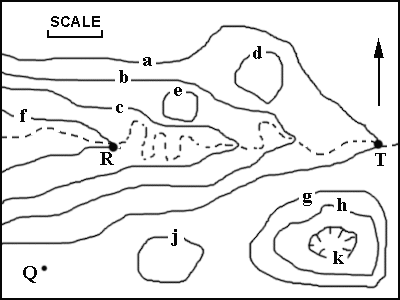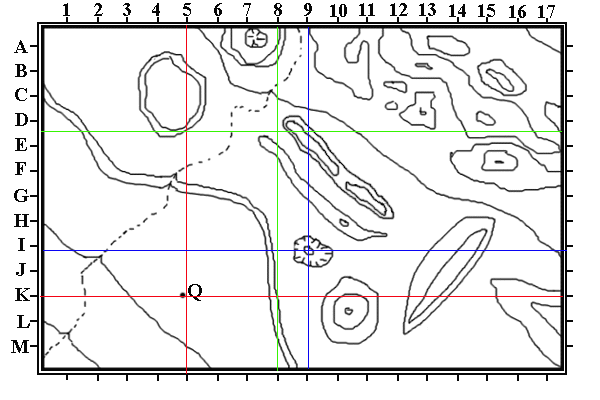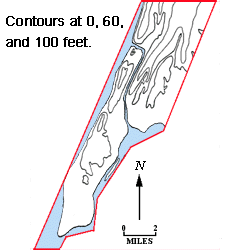|
Questions 1 through 6. Refer to Lou-Lulu dialogs and other explanatory material.
7. Refer to Figures 3 and 4. Assume the length of the scale bar is 25 miles, the contour interval is 50 feet, and the elevation of point Q is 728 feet.

FIGURE 3 | | 
FIGURE 4 |
- In what general compass direction is the stream flowing?
It is flowing towards the west.
- What it is the straight-line distance between points R and T?
about 5 scale bar lengths = about 125 miles.
- What is the distance along the stream between points R and T?
about 8 to 9 scale bar lengths = 200 to 225 miles.
- What is the average gradient of the stream between points R and T?
150 feet in about 200 miles = 0.75 ft/mile; 150 feet in 225 miles = 0.67 ft/mile
- What is the elevation of contour f?
550 feet.
- What is the difference in elevation between contour d and contour k?
d = 700; k = 800; the difference is 100 feet.
- What is the azimuth direction going from point R to point Q?
About 210 degrees.
8. Refer to Figure 5 below.

FIGURE 5
Identify locations by use of the grid intersections. For example, point Q is closest to grid intersection K-5 (intersection of red lines).
For each of the following descriptions, choose the location of the best example.
- The top of a hill located within a depression is located at:
I-9 (intersection of blue lines)
- The northwest end of a valley located between two parallel ridges is located at:
midway between E-8 and D-8 (intersection of green lines)
9. Refer to Figure 6, below.
- Which NYC boroughs or parts of boroughs are represented on the map shown in Figure 6? Manhattan and the western Bronx.
- In general terms, briefly describe the topography.
Manhattan: Manhattan is a narrow, elongated island that trends NE-SW. It is roughly 12 miles long and two miles wide. The northernmost part of the borough is a well-defined, narrow ridge that rises to over 100 feet and occupies the entire width of the island. Further south, a lower, irregular plateau occupies the west-central region. The southermost part of the island is quite low and flat.
Western Bronx: Most of the western Bronx consists of a series of parallel, elongate ridges and valleys that trend NE-SW and rise to over 100 feet. The southern and southeasternmost parts shown are low and flat.

FIGURE 6.
|

